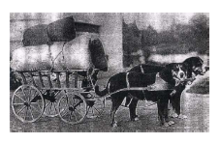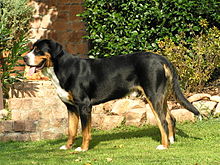
The American Kennel Club (AKC) is a registry of purebred dog pedigrees in the United States. In addition to maintaining its pedigree registry, this kennel club also promotes and sanctions events for purebred dogs, including the Westminster Kennel Club Dog Show, an annual event which predates the official forming of the AKC, the National Dog Show and the AKC National Championship. The AKC is a non-member partner with the Fédération Cynologique Internationale. The AKC recognizes 200 dog breeds, as of 2022.

The Affenpinscher is a German breed of small toy dog of Pinscher type. Originally developed as a mouser, the Affenpinscher's distinctive appearance and charming personality has gained popularity as a companion among dog lovers worldwide.

The Bernese Mountain Dog is a large dog breed from Bern, Switzerland and the Swiss Alps, being one of the four breeds of Sennenhund-type dogs, with roots in the Roman mastiffs. The name Berner refers to the breed's area of origin in the canton of Bern, and Sennenhund is derived from the German Senne and Hund ("hound/dog"), as they accompanied the alpine herders and dairymen called Senn. This breed was originally kept as a general farm dog and large Sennenhunde in the past were also used as draft animals pulling carts. The breed was officially established in 1912.

The Fédération Cynologique Internationale is the largest international federation of national kennel clubs and purebred registries. The FCI is based in Thuin, Belgium and has 98 members and contract partners.
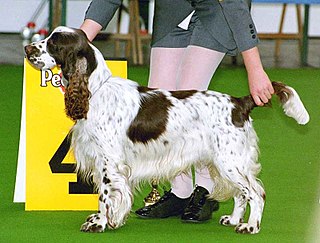
A dog show is an animal show, an event where dogs are exhibited. A conformation show, also referred to as a breed show, is a kind of dog show in which a judge, familiar with a specific dog breed, evaluates individual purebred dogs for how well the dogs conform to the established breed type for their breed, as described in a breed's individual breed standard.

The Poodle, called the Pudel in German and the Caniche in French, is a breed of water dog. The breed is divided into four varieties based on size, the Standard Poodle, Medium Poodle, Miniature Poodle and Toy Poodle, although the Medium Poodle is not universally recognised. They have a distinctive thick, curly coat that comes in many colors and patterns, with only solid colors recognized by breed registries. Poodles are active and intelligent, and are particularly able to learn from humans. Poodles tend to live 10–18 years, with smaller varieties tending to live longer than larger ones.
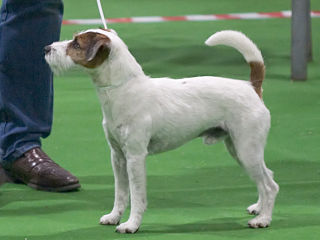
The Parson Russell Terrier is a breed of small white terrier that was the original Fox Terrier of the 18th century. The breed is named after the Reverend Jack Russell, credited with the creation of this type of dog. It is the recognised conformation show variety of the Jack Russell Terrier and was first recognised in 1990 in the United Kingdom as the Parson Jack Russell Terrier. In America, it was first recognised as the Jack Russell Terrier in 1997. The name was changed to its current form in 1999 in the UK and by 2008 all international kennel clubs recognised it under the new name.

The Entlebucher Sennenhund or Entlebucher Mountain Dog is a medium-sized herding dog, it is the smallest of the four regional breeds that constitute the Sennenhund dog type. The name Sennenhund refers to people called Senn, herders in the Swiss Alps. Entlebuch is a region in the canton of Lucerne in Switzerland. The breed is also known in English as the Entelbuch Mountain Dog, Entelbucher Cattle Dog, and similar combinations.

The St. Bernard or Saint Bernard is a breed of very large working dog from the Western Alps in Italy and Switzerland. They were originally bred for rescue work by the hospice of the Great St Bernard Pass on the Italian-Swiss border. The hospice, built by and named after the Alpine monk Saint Bernard of Menthon, acquired its first dogs between 1660 and 1670. The breed has become famous through tales of Alpine rescues, as well as for its large size and gentle temperament.

The Pinscher is a group of German dog breeds, developed originally as ratters on farms or as guard dogs. In the twenty-first century they are commonly kept as companion animals.

Albert Heim was a Swiss geologist, noted for his three-volume Geologie der Schweiz.

The Miniature Pinscher, also known as the Zwergpinscher and Mini Pin, is a small breed of dog of the pinscher type originating in Germany. While the breed's visual similarities to the Toy Manchester Terrier, which somewhat resembles the Pinscher breeds, remain a matter of controversy, genetic research has shown that the two breeds have shared, unique ancestry. The ancestors of the Toy Manchester and Miniature Pinscher may have become geographically separated many centuries ago and retained similarities simply through breeding selection for the same traits; nevertheless, the 2017 research also showed that the two breeds remain more closely related to each other than to other breeds. The breed's ancestors may also include the German Pinscher, Italian greyhounds and dachshunds. The Miniature Pinscher's known origins are in Germany, where it was often referred to as the Zwerg Pinscher in historical documents. German Kennel Club documents also refer to the Miniature Pinscher as the "reh" Pinscher, but this term is only used for a dog of stag-red color, "reh" referring to a small red deer formerly found in German forests. The Miniature Pinscher originated several centuries ago as an efficient barnyard ratter.

The Coton de Tuléar is a breed of small dog named for the city of Tuléar in Madagascar. This breed is thought to have originated from a group of small white dogs that swam across the Malagasy channel following a shipwreck. Known for its cotton-like coat, the Coton de Tuléar typically grows to no more than 18 pounds (8.2 kg), and are white, sometimes with grey, tan, black, or tri-colored markings. The Coton de Tuléar Day is celebrated on November 26.
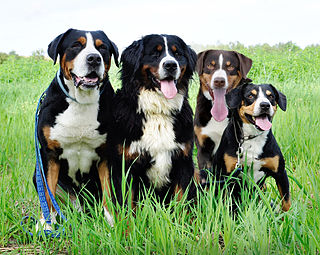
Sennenhunds, called Swiss mountain dogs or Swiss cattle dogs in English, are a type of dog originating in the Swiss Alps. The Sennenhund are farm dogs of the general livestock guardian type. There are four breeds of Sennenhunds, all sporting a unique tricolor coat. While the two larger ones share a heavy build and a calm temperament, the two smaller ones are more agile. The breeds range from medium in size to very large. The name Sennenhund refers to people called Senn or Senner, Swiss Alpine herdsmen and dairymen, and does not translate as "mountain" or "cattle".

The Appenzeller Sennenhund is a Swiss breed of medium-sized working dog. It originates in the Appenzell region of north-eastern Switzerland, and is one of four regional breeds of Sennenhund or Swiss mountain dog, all of which are characterised by a distinctive tricolour coat.

The Kromfohrländer is a modern German breed of companion dog. It originated in Germany in the years after the end of the Second World War. There are two coat types, a smooth-haired and a rough-haired.

Danish–Swedish farmdog is a breed of dog that has its origin in Denmark and southern Sweden, but has become popular all over Scandinavia. It is a native breed which has historically lived on farms in the eastern part of Denmark and southernmost part of Sweden, serving as a guard dog, rat catcher and hunting dog. The breed's soft and gentle temperament also makes them excellent companion dogs. There are some indications that the breed originates from the pinscher breeds and the British white hunting terriers.

The French Spaniel is a breed of dog of the Spaniel-like setter. It was developed in France and Canada as a hunting dog, descended from dogs of the 14th century. Popular with royalty during the Middle Ages, it nearly became extinct by the turn of the 20th century but was saved by the efforts of Father Fournier, a French priest. One of the largest breeds of Spaniel, it typically has a white coat with brown markings. It is a friendly breed that has few health issues, but can be affected by a syndrome called acral mutilation and analgesia. The breed is recognised by Canadian and international kennel clubs but not by The Kennel Club (UK). The American Kennel Club has included the breed in its Foundation Stock Service, the first step to full recognition.

The Russian Toy is a very small breed of dog originally bred in Russia from the English Toy Terrier. There are two types of coats in the breed: smooth coat and long coat. The smooth-coated variety was previously known as the Russian Toy Terrier and long-coated as the Moscow Long-Haired Toy Terrier. Both were brought together under the same Russian Toy Terrier name in 1988 and the "Terrier" was dropped from the name when the breed was added in 2006 to the official list of breeds registered with the Fédération Cynologique Internationale and has been registered in the Foundation Stock Service of the American Kennel Club since 2008, allowed to compete in AKC companion events since 2010. The first official breed standard of the two varieties was written in 1966 in Russia.

The Miniature American Shepherd, frequently abbreviated MAS, is a small herding dog breed. The MAS is highly intelligent and biddable. The breed is often trained for dog sports such as herding, agility, obedience, canine freestyle, flyball, and others. The Miniature American Shepherd was recognised by the American Kennel Club (AKC) in 2015 and is the club's 186th breed. In September 2019, the Fédération Cynologique Internationale (FCI) officially accepted the breed.


